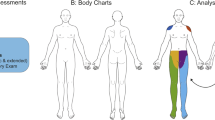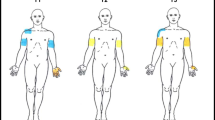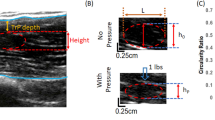Abstract
Regional soft-tissue complaints are commonplace, and they usually relate to a disease process, such as strain, inflammation or degeneration of a muscle, tendon or related muscle–tendon unit. The clinical features and investigations of the causative processes of these complaints are characteristic, and outcomes to treatments are usually predictable and satisfactory. Regional pain syndromes are different: these syndromes present with regional pain and tenderness, and other sensory symptoms unaccounted for by a simple musculoskeletal mechanistic explanation. Approved classification criteria for regional pain syndromes are lacking, and these syndromes are poorly understood and frequently misdiagnosed. Regional pain syndromes often occur after injury and overlap extensively with other musculoskeletal pain syndromes, in terms of clinical signs and symptoms. The clinician and patient are often confused about the nature of the problem and routine treatments directed to putative tissue damage will fail. Review of the epidemiology of regional pain syndromes combined with knowledge of other similar pain syndromes has enabled an evolving understanding of the condition. The musculoskeletal and central nervous systems both contribute to regional pain syndromes, through spine-related pain mechanisms and central sensitization, respectively. The patient's emotional state, particularly the effect on pain modulation, links these two systems.
Key Points
-
Regional pain syndrome is characterized by regional pain and tenderness, which has a non-neuroanatomic distribution, with the symptomatic area involving the spine
-
Regional pain syndrome shares clinical features with both fibromyalgia syndrome and complex regional pain syndrome
-
Epidemiologic studies implicate a more significant role for psychosocial factors than ergonomic factors in these syndromes
-
Central sensitization and spine-associated pain mechanisms are probably major contributors to the syndrome
-
Regional pain syndrome is managed using similar approaches to those used for fibromyalgia syndrome, which address sensitization through education, neuroactive drugs, exercise and psychological techniques
This is a preview of subscription content, access via your institution
Access options
Subscribe to this journal
Receive 12 print issues and online access
$209.00 per year
only $17.42 per issue
Buy this article
- Purchase on Springer Link
- Instant access to full article PDF
Prices may be subject to local taxes which are calculated during checkout

Similar content being viewed by others
References
Granges G and Littlejohn G (1993) Pressure pain threshold in pain-free subjects, in patients with chronic regional pain syndromes, and in patients with fibromyalgia syndrome. Arthritis Rheum 36: 642–646
Stanton-Hicks M et al. (1995) Reflex sympathetic dystrophy: changing concepts and taxonomy. Pain 63: 127–133
Harden RN and Bruehl SP (2005) Diagnostic criteria: the statistical derivation of the four criterion factors. In CRPS: Current diagnosis and therapy, 45–79 (Eds Wilson PR et al.) Seattle, WA: IASP Press
Wolfe F et al. (1990) The American College of Rheumatology 1990 Criteria for the Classification of Fibromyalgia. Report of the Multicenter Criteria Committee. Arthritis Rheum 33: 160–172
Wigley R (1999) Can fibromyalgia be separated from regional pain syndrome affecting the arm? J Rheumatol 26: 515–516
Kurppa K et al. (1979) Peritendinitis and tenosynovitis. A review. Scand J Work Environ Health 5 (Suppl 3): 19–24
Helliwell PS et al. (2003) Towards epidemiological criteria for soft-tissue disorders of the arm. Occup Med (Lond) 53: 313–319
Littlejohn GO (2005) Musculoskeletal Pain. J Royal Coll Physicians Edinb 35: 340–344
Atherton K et al. (2006) Predictors of persistent neck pain after whiplash injury. Emerg Med J 23: 195–201
Magnusson T (1994) Extracervical symptoms after whiplash trauma. Cephalalgia 14: 223–227
Littlejohn GO (1989) Fibrositis/fibromyalgia syndrome in the workplace. Rheum Dis Clin North Am 15: 45–60
Holm LW et al. (2007) Widespread pain following whiplash-associated disorders: incidence, course, and risk factors. J Rheumatol 34: 193–200
Shir Y et al. (2006) Whiplash and fibromyalgia: an ever-widening gap. J Rheumatol 33: 1045–1047
Rosomoff HL et al. (1989) Physical findings in patients with chronic intractable benign pain of the neck and/or back. Pain 37: 279–287
Littlejohn GO and Granges G (1995) The relationship between vertebral dysfunction and clinical features of fibromyalgia syndrome. J Orthop Rheumatology 8: 97–105
Miller MH and Topliss DJ (1988) Chronic upper limb pain syndrome (repetitive strain injury) in the Australian workforce: a systematic cross sectional rheumatological study of 229 patients. J Rheumatol 15: 1705–1712
Berglund A et al. (2006) The influence of prognostic factors on neck pain intensity, disability, anxiety and depression over a 2-year period in subjects with acute whiplash injury. Pain 125: 244–256
Tough EA et al. (2007) Variability of criteria used to diagnose myofascial trigger point pain syndrome-evidence from a review of the literature. Clin J Pain 23: 278–286
Smythe HA (1994) The C6-7 syndrome—clinical features and treatment response. J Rheumatol 21: 1520–1526
Hocking B (1989) 'Repetition strain injury' in Telecom Australia. Med J Aust 150: 724
Rossignol AM et al. (1987) Video display terminal use and reported health symptoms among Massachusetts clerical workers. J Occup Med 29: 112–118
Hocking B (1996) Some social and cultural anthropologic aspects of musculoskeletal disorders as exemplified by the Telecom Australia RSI epidemic. In Beyond Biomechanics, 145–158 (Eds Moon S and Sauter S) London: Taylor and Francis
Walker-Bone K and Cooper C (2005) Hard work never hurt anyone: or did it? A review of occupational associations with soft tissue musculoskeletal disorders of the neck and upper limb. Ann Rheum Dis 64: 1391–1396
Macfarlane GJ et al. (2000) Role of mechanical and psychosocial factors in the onset of forearm pain: prospective population based study. BMJ 321: 676–679
Walker-Bone K et al. (2004) The anatomical pattern and determinants of pain in the neck and upper limbs: an epidemiologic study. Pain 109: 45–51
Walker-Bone KE et al. (2003) Soft-tissue rheumatic disorders of the neck and upper limb: prevalence and risk factors. Semin Arthritis Rheum 33: 185–203
Helliwell PS (2003) Psychosocial factors in diffuse upper limb disorder. J Rheumatol 30: 7–9
van der Windt D et al. (2002) Neck and upper limb pain: more pain is associated with psychological distress and consultation rate in primary care. J Rheumatol 29: 564–569
Ferrari R and Russell AS (1997) The whiplash syndrome—common sense revisited. J Rheumatol 24: 618–623
Macfarlane GJ (1999) Generalized pain, fibromyalgia and regional pain: an epidemiological view. Baillieres Best Pract Res Clin Rheumatol 13: 403–414
Koelbaek Johansen M et al. (1999) Generalised muscular hyperalgesia in chronic whiplash syndrome. Pain 83: 229–234
Smythe H (1988) The 'repetitive strain injury syndrome' is referred pain from the neck. J Rheumatol 15: 1604–1608
Buskila D and Neumann L (2000) Musculoskeletal injury as a trigger for fibromyalgia/posttraumatic fibromyalgia. Curr Rheumatol Rep 2: 104–108
Graven-Nielsen T et al. (2006) Central sensitization, referred pain, and deep tissue hyperalgesia in musculoskeletal pain. In Proceedings of the 11th World Congress on Pain, 217–230 (Eds Flor H et al.) Seattle, WA: IASP Press
Helme RD et al. (1987) Neurogenic flare responses in chronic rheumatic pain syndromes. Clin Exp Neurol 23: 91–94
Arroyo JF and Cohen ML (1992) Unusual responses to electrocutaneous stimulation in refractory cervicobrachial pain: clues to a neuropathic pathogenesis. Clin Exp Rheumatol 10: 475–482
Greening J et al. (2003) Sensory and autonomic function in the hands of patients with non-specific arm pain (NSAP) and asymptomatic office workers. Pain 104: 275–281
Tucker AT et al. (2007) Comparison of vibration perception thresholds in individuals with diffuse upper limb pain and carpal tunnel syndrome. Pain 127: 263–269
Mailis-Gagnon A (2006) Disrupted central somatosensory processing in CRPS: a unique characteristic of the syndrome? Pain 123: 3–5
Littlejohn GO et al. (1987) Increased neurogenic inflammation in fibrositis syndrome. J Rheumatol 14: 1022–1025
Chen C et al. (2006) Distribution of A-delta and C-fiber receptors in the cervical facet joint capsule and their response to stretch. J Bone Joint Surg Am 88: 1807–1816
Shannon AL et al. (2006) Alberta rodeo athletes do not develop the chronic whiplash syndrome. J Rheumatol 33: 975–977
Staud R (2004) Fibromyalgia pain: do we know the source? Curr Opin Rheumatol 16: 157–163
Littlejohn GO (2004) Balanced treatments for fibromyalgia. Arthritis Rheum 50: 2725–2729
Clauw DJ and Williams DA (2002) Relationship between stress and pain in work-related upper extremity disorders: the hidden role of chronic multisymptom illnesses. Am J Ind Med 41: 370–382
Diatchenko L et al. (2006) Idiopathic pain disorders—pathways of vulnerability. Pain 123: 226–230
Krause P et al. (2006) TMS motor cortical brain mapping in patients with complex regional pain syndrome type I. Clin Neurophysiol 117: 169–176
Maihofner C et al. (2004) Cortical reorganization during recovery from complex regional pain syndrome. Neurology 63: 693–701
Hadler NM (1996) If you have to prove you are ill, you can't get well. The object lesson of fibromyalgia. Spine 21: 2397–2400
Smith BH et al. (2007) Epidemiology of chronic pain, from the laboratory to the bus stop: time to add understanding of biological mechanisms to the study of risk factors in population-based research? Pain 127: 5–10
Borg-Stein J (2006) Treatment of fibromyalgia, myofascial pain, and related disorders. Phys Med Rehabil Clin N Am 17: 491–510, viii
Dadabhoy D and Clauw DJ (2006) Therapy Insight: fibromyalgia—a different type of pain needing a different type of treatment. Nat Clin Pract Rheumatol 2: 364–372
Hadler NM (2006) Socioeconomics of back pain. Nat Clin Pract Rheumatol 2: 230–231
Bennett R and Nelson D (2006) Cognitive behavioral therapy for fibromyalgia. Nat Clin Pract Rheumatol 2: 416–424
Author information
Authors and Affiliations
Corresponding author
Ethics declarations
Competing interests
The author declares no competing financial interests.
Rights and permissions
About this article
Cite this article
Littlejohn, G. Regional pain syndrome: clinical characteristics, mechanisms and management. Nat Rev Rheumatol 3, 504–511 (2007). https://doi.org/10.1038/ncprheum0598
Received:
Accepted:
Issue Date:
DOI: https://doi.org/10.1038/ncprheum0598



